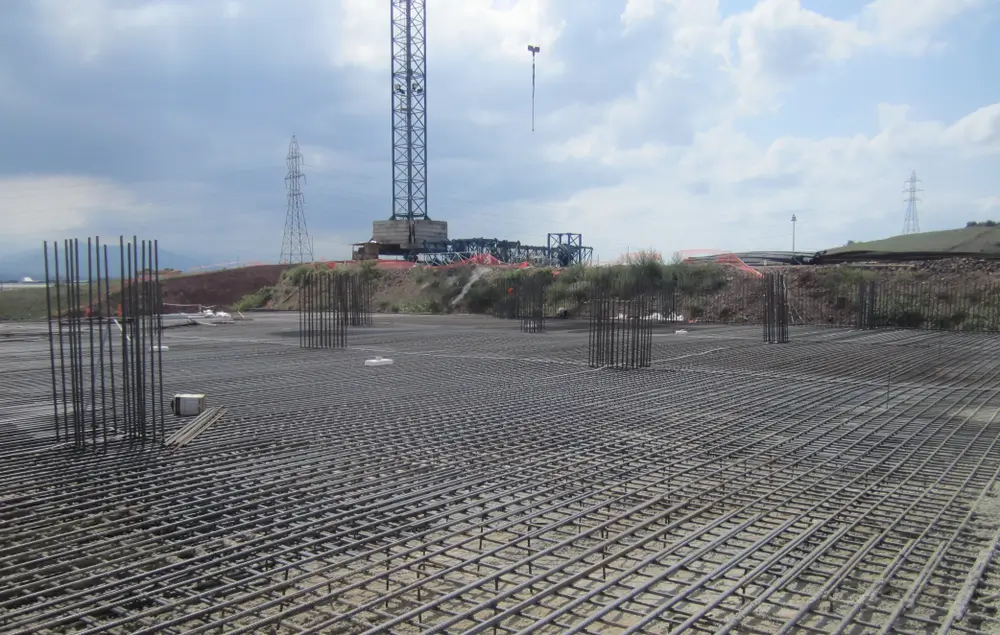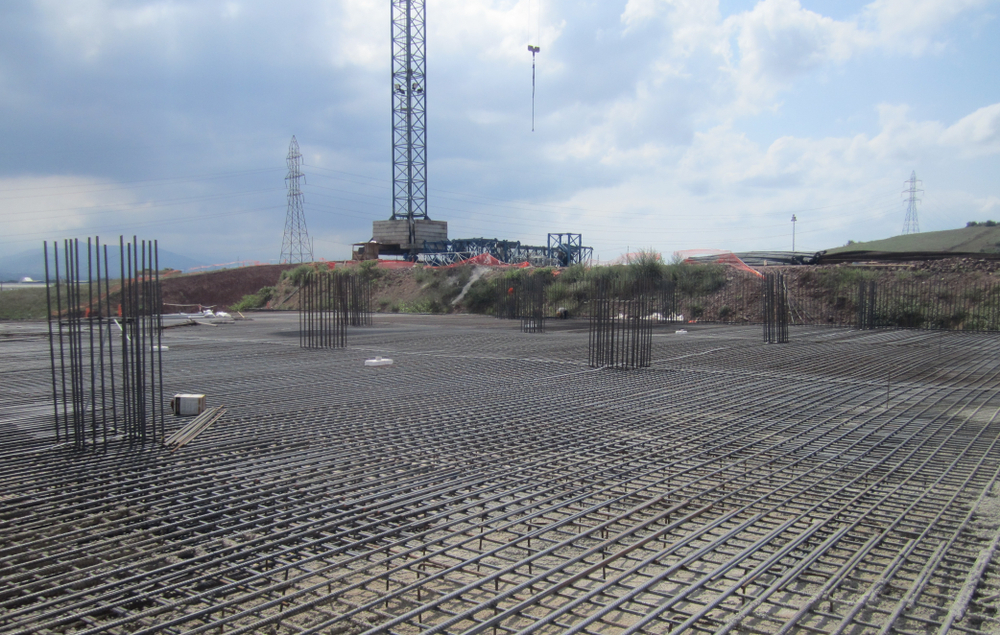Introduction
A mat foundation is a comprehensive thick concrete slab that entirely covers the area beneath a superstructure. It accommodates all columns and walls serving to distribute the load of the building across the surface of soil. This type of foundation is preferable when the soil quality under the building is soft or weak. Instead of employing small footings below each column, a mat foundation combines all columns and walls into one stable base statue.
Mat foundations are significant in contemporary constructions of buildings and bridges that carry typical heavy loads or are constructed on-site with weak soil strata. They help in eliminating the problem of differential settlement which might occur if various portions of a building settle differently. This type of foundation is commonly used in high-rise buildings, factories, and structures that are intended to support heavy machinery. It is also beneficial in regions where the groundwater level is high, making it difficult to construct deep foundations. It can be concluded that mat foundations contribute to constructing safe and robust buildings even in difficult soils.
What is the Mat Foundation?

Mat foundation has a definition of being a larger, thicker supporting concrete slab beneath a structure. The mat foundation is unlike traditional foundations which have small footings under each column or wall. Instead, it is spread out over the total area of the building imposing unifying forces on all columns and walls, thus enabling uniform weight distribution over the soil.
Weak and soft soil can be an issue for construction if not considered carefully, which is where Mat Foundations come into play. Mat foundations also come in handy for heavy structures such as factories, towering buildings, and places with big equipment. Parts of buildings sinking more than others is an issue that mat foundations deal with through even distribution of load. This allows the structure to be stable and safe.
Types of Mat Foundations
1. Solid Slab Mat
Solid slab mat has a definition of being a thick and flat concrete slab that extends over the entire building area. This type of mat is particularly advantageous for light structures with smaller footprints and softer soil conditions that can lead to differential settlement under the foundation footprint.
2. Beam and Slab Mat
With this type of mat, precast concrete beams spaced apart and running in one direction are incorporated within a thick floor slab. These beams add additional strength which supports taller buildings, heavy industrial structures, or weak soil regions needing better load distribution and increased stability.
3. Cellular Mat Foundation
A cellular mat foundation (box mat) is a type of mat that incorporates a grid of hollow concrete boxes. This type of structure works best for very high buildings or projects for which less material and lighter weight of the mat foundation saves on expenses and construction materials.
4. Raft Foundation
A foundation mat is also frequently referred to as a slab foundation. It is usually adopted for structures established on loose, soft, or weak underlying soil to reduce the effects of uneven sinking and improve overall foundation stability.
Mat Foundation Construction Process
Site Preparation and Soil Testing
The area is cleared and has to be leveled and soil testing is performed to assess the strength and properties of the soils attended to. This information helps the engineers in choosing the appropriate mat foundation design and ensures the safety of the building weight.
Placement of Formwork and Reinforcement
The formwork is prepared to serve as a mold for the mat foundation and retain concrete during pouring. Concrete is further strengthened by placing steel reinforcement bars (rebar) into the formwork. This will enable the mat to resist cracking while evenly distributing the weight of the building.
Concrete Pouring and Curing Process
After the reinforcement is placed, concrete is poured over the entire area of the mat foundation. To ensure that the concrete gains strength in the most even manner, appropriate curing is conducted to keep the concrete moist. This process is beneficial in making the foundation strong and durable for the lifetime of the building.
Key Mat Foundation Construction Quality Control Issues
Curing time, concrete mix, and reinforcement placement are critical aspects of formwork quality control. Periodic checks are conducted to determine formwork integrity, concrete compaction, and alignment accuracy. These actions ultimately guarantee that the mat foundation is strong, stable, and durable over a long period.
Mat Foundations Use and Application
For areas with weak or compressible soils
Mat foundations are designed to disperse the load of the structure into a broader region, which in turn reduces the stress on the weak or soft soils. This allows for the avoidance of differential settlement which aids in keeping the building stable.
Ideal For Heavily Loaded Structures Such As High-Rise Towers Or Industrial Factories
When buildings have heavy loads, for example, high-rise towers or huge factories with colossal machinery, it is the mat foundation that offers support by providing the groundwork on which the entire structure is built to whisk away the weight of the edifice.
Common in Water Storage Tanks, Basements, and parking structures
They are popular in buildings having a basement or an underground parking garage because they facilitate the construction of a basic floor slab. They are also ideal for water storage tanks which need a stout base.
Benefits mat foundation in seismic-prone regions
In regions prone to earthquakes, mat foundations are beneficial because they can absorb and dissipate seismic forces, minimizing possible damage to the structure while allowing the building to remain intact by linking and anchoring the entire building base.
Advantages of Mat Foundations
Provides a base for the rest of the building.
The rest of the building cannot be supported because the foundation itself will hover and rest on the softer soil due to the mobile mat foundation. Mat foundation can float and distribute the load for the breadth of the building around its base. In doing so, it lifts the building from collapse upon soft soil while giving precision to the construction of the building without hindering its shape or stability.
Reducing differential settlement
Since the whole foundation acts as a single network, all parts of the building submissively sink into one. This reinforces the structure to avoid breach or damage from decay arising from irregular sinking of the structure.
Mat foundations are best suited to structures with a heavy Superstructure Load and Great Walls Such As Skyscrapers and Multi-Story Industrial Buildings or buildings with heavy machinery.
Considerations in Mat Foundation Design
Soil Bearing Capacity The capacity of the soil to carry the load of the building rests on its ability to support weight. Weaker or softer soils need a thicker mat foundation designed to spread the load of the building over a larger area easily. Engineers need to conduct soil tests to assess the strength of a certain soil type and determine what mat foundation thickness and reinforcement is most applicable to it.
Building Height and Load are Placed on the vertical skeletons (building columns) and on top of them are placed in larger flat boxes (equipped floors). Taller buildings along with structures having heavy load-bearing equipment impose vertical pressure on the bottom. In this case, the mat foundation also is obliged to bear these loads by changing the thickness, reinforcing, and type of mat used in order to avoid cracking, settlement, and differential sinking over time.
Ground Water Table
Groundwater tables that are too high may pose problems when construction work is underway. The soil may get softened and there will be ground pressure acting from below the foundation. Designers may need to add drip walls and waterproof the structures with thick slabs as well as keep the mat foundation stable.
Construction Materials and Cost Factors
The quality and kind of concrete used as well as the steel reinforcement impacts the mat foundation’s blend of support and longevity. Larger mats require more resources which increases the labor and material costs. Engineers balance safety performance and costs when deciding the final design of the foundation.
Mat Foundation vs Other Foundation Types
Mat Foundation vs Shallow Foundations (Strip, Isolated, Combined)
Shallow foundations consist of strip and combined footings where, for each column or wall, there is a footing directly under it. These types of bases are efficient for smaller structures with reasonable loads and dense soil. Unlike these, mat foundations span the entire footprint of a building in order to evenly distribute the load. They are desirable for large constructions on soft or uneven soils.
Mat Foundation versus Deep Foundations (Piles and Caissons)
Piles and caissons are examples of deep foundations. They are used to support very tall structures or buildings in deep weak soils because they transfer the building load to greater depths, often further down to where more solid soils are located. Mat foundations are used for medium to large sized structures located on moderately soft soils where the upper layers of soil can bear the load if the load is spread uniformly across the surface.
When Mat Foundation Becomes the Right Choice
Use a mat foundation when the upper levels of soil are insufficient to support individual footings but a deep foundation is not required. This type of foundation is also advisable for structures with heavy loads, a basement, or large pieces of machinery, as spreading the weight helps avoid unbalanced settlement and other structural complications.
Conclusion
Structures that are large and heavy require robust support resting on soft and compressible soil and mat foundation allows just that. It evenly redistributes the weight of the structure to prevent unbalanced settlement and therefore enhances the support overall stability and safety of the structure. This makes highly compacted zones such as those around high-rise buildings, industrial facilities, and structures with deep basements or underground parking highly suitable for mat foundations.
With buildings getting taller and sites often located on poor quality soils, the construction industry is shifting towards taller buildings alongside mat foundations for reliable support and durability. These kinds of foundations are helpful in earthquake prone areas as they help in absorbing and distributing the earthquake forces across the foundation which prevents damage.
Here at Construct Guide, we know how important it is to choose the foundation type for any given project. With mats still being the preferred solution for complex sites, heavy loads, and long-lasting structural performance, we continue to offer our utmost support towards such foundations.

